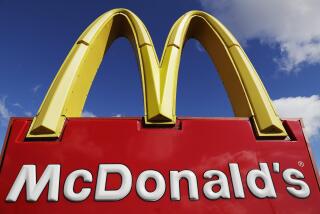At Denny’s, the New Lure Is Nutrition
- Share via
A new twist has been added to the highly competitive fast-food world where convenience and price have long been the battleground on which the burger/chicken chains fought for patrons. It seems that in recent weeks nutrition has surfaced as a customer lure.
Partially responsible for the precedent-setting tactic was a national survey of the salt, fat and calorie content of some of America’s favorite away-from-home foods compiled by the Center for Science in the Public Interest.
Since the survey was made public, Denny’s Restaurants Inc. has distributed fliers throughout its 1,100 outlets touting the fact that its fried foods are “healthier” than those of the competition. The center’s study found that the La Mirada-based company was the only nationwide firm using 100% vegetable oil for frying.
Virtually all the other chains surveyed used animal fats or a more heavily saturated vegetable oil for preparing items such as fish, chicken or potatoes. The comparison is noteworthy because of medical research which indicates that a diet high in fat increases an individual’s risk of heart disease and cancer of the breast, colon and prostrate.
According to the center’s statistics, the oil used by Denny’s has only 18% saturated fat compared to a saturated-fat level of between 45% and 50% for the oils found at McDonald’s, Wendy’s, Carl’s Jr. and Bob’s Big Boy. In some cases, a mixture of 95% beef fat and 5% vegetable oil is used to prepare items such as fries.
Cost Cited as Factor
Denny’s promotional leaflet also points out that its competitors are using the less desirable oils simply as a cost-cutting measure.
“Vegetable oil is significantly more expensive than animal fat. This is probably why some chains listed in the (center’s) study cited cost as a factor for using animal fat,” the flyer states.
A spokesman for Denny’s said the restaurant chain is not telling people how to eat, but just providing an alternative and stated, “If you believe vegetable oil is better for you than meat fat, then you’ll like the products (we sell).”
Normally the food industry’s most severe critic, the Center for Science’s executive director Michael Jacobson had kind words for the Denny’s effort.
“Denny’s happens to have been using a good vegetable oil (for their fried foods). Now they’re publicizing it,” he said. “(The chains) are competing on the basis of good nutrition for a change and that’s great.”
Denny’s lead is now being followed by Burger King. The nation’s second-largest fast food outlet announced recently that it has begun cooking most of its fried foods in 100% vegetable oil. The chain had previously used a mixture of 93% animal fat and 7% vegetable oil for its chicken sandwich, fish sandwich, onion rings and chicken pieces.
A representative of Burger King said that the firm still cooks its French fries in the animal-fat substance. However, the company is researching various vegetable oil mixtures to eventually replace the beef tallow.
“Consumers are very aware of the importance of nutrition and the lower cholesterol levels of vegetable oils,” said Joyce Myers, a Burger King official. “We are staying in touch with what consumers want and demand.”
Ordering Some Statistics--Only the most disciplined lunch or dinner patron can resist an occasional order of slightly greasy French fries, a double cheeseburger or plateful of fried fish.
So, resigned to the fact that nearly every American looks for a quick and convenient bite to eat now and then, the Center for Science in the Public Interest has published its survey on the nutritional content of fast foods in poster form.
Fast-food devotees may not be thrilled by some of the findings. At the same time, all the news is not nutritionally distressing.
To make the poster understandable, the center compiled a “gloom rating,” which is a number derived from the total fat, salt, sugar and calories found in a single fast-food item. High gloom numbers indicate whether a food is meant to be avoided or approached carefully. The gloom numbers assigned by the center range from zero to as high as 105.
Another helpful guide is that the poster measures fat content for each food by teaspoons per serving rather than the more unwieldy milligram levels.
A few highlights from the “Fast Food Eating Guide” are worth noting.
Among those foods with low gloom ratings are Kentucky Fried Chicken’s mashed potatoes with a gloom rating of 4 and no teaspoons fat, Carl’s Jr. chicken breast with a 9 and one teaspoon fat, McDonald’s plain hamburger with a 16 and three teaspoons fat and Wendy’s omelet with mushrooms, onions and green pepper with a 16 rating and three teaspoons fat.
On the other end of the scale is Wendy’s baked potato with bacon and cheese at a 41 gloom and seven teaspoons fat, Burger King’s specialty chicken sandwich with a 54 rating and 10 teaspoons fat, Wendy’s triple cheeseburger with a 85 rating and 15 teaspoons fat and Jack-in-the-Box scrambled egg breakfast with a 56 rating and 10 teaspoons of fat.
The highest rating of all comes under the category of entire meals. The leader in this category is a lunch or dinner at Wendy’s consisting of a triple cheeseburger, French fries and a cola. Total damage is a 105 gloom rating and a meal equivalent to 19 teaspoons of fat.
The guide is available by writing the Center for Science, 1501 16th St. NW, Washington, D.C. 20036. Enclose $3.95 per poster.
More to Read
Inside the business of entertainment
The Wide Shot brings you news, analysis and insights on everything from streaming wars to production — and what it all means for the future.
You may occasionally receive promotional content from the Los Angeles Times.










